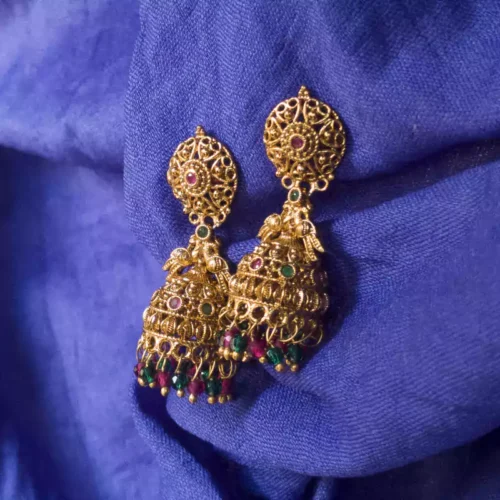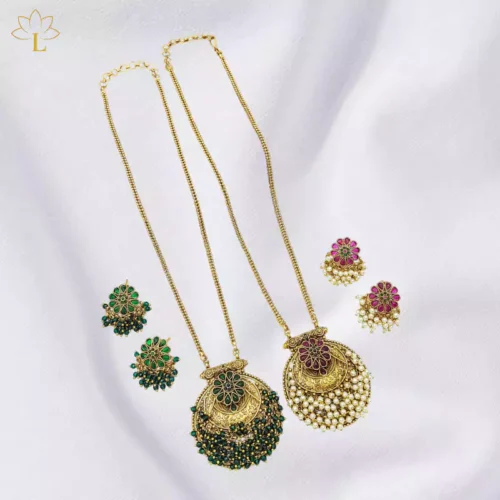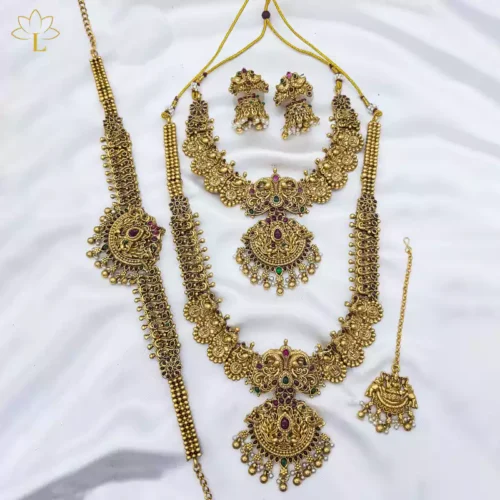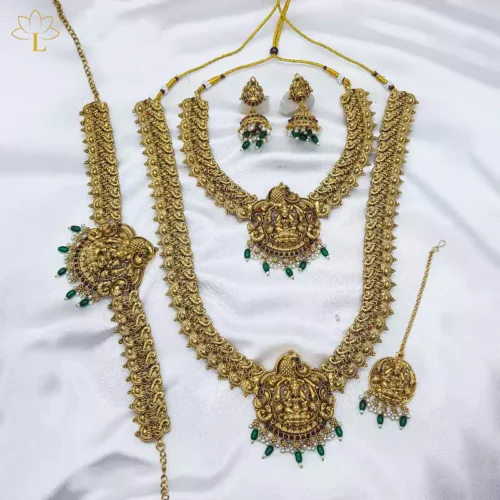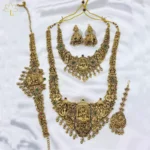Artificial jewellery, also known as imitation jewellery, is a stylish and affordable way to enhance your look. At Lazola.in, we believe that your jewellery should always shine bright — even if it’s not made of real gold or silver. Over time, artificial jewellery can lose its sparkle due to exposure to air, moisture, sweat, and makeup. But don’t worry! You don’t need to rush to a jeweller to fix it.
In this guide, we’ll teach you how to polish artificial jewellery at home using simple, safe, and effective methods. These techniques are perfect for maintaining the beauty of your Lazola jewellery pieces and extending their life.


Gold-Plated Temple Jhumka Earrings with Circle Stud
Original price was: ₹400.00.₹260.00Current price is: ₹260.00.
Necklace Set with Green and Ruby Stones 0100
Original price was: ₹1100.00.₹875.00Current price is: ₹875.00.
Bridal Jewellery Set 0060
Original price was: ₹1650.00.₹1275.00Current price is: ₹1275.00.
Bridal Jewellery Set 0085
Original price was: ₹1600.00.₹1230.00Current price is: ₹1230.00.
Table of Contents
Why Does Artificial Jewellery Lose Its Shine?
Before we dive into the solutions, it’s important to understand why artificial jewellery tarnishes:
- Oxidation: Exposure to air and moisture can cause fading and discolouration.
- Sweat and skin oils: Regular wear can lead to build-up of oils and sweat.
- Perfumes and lotions: Chemicals in cosmetic products can damage the finish.
- Improper storage: Keeping jewellery in open air or with metals can accelerate tarnishing.
Knowing these factors helps you prevent further damage and polish your jewellery the right way.
Precautions Before You Start Polishing
Before you begin cleaning or polishing, keep these precautions in mind:
- Avoid using harsh chemicals or metal polish on artificial jewellery.
- Do not scrub with steel brushes or hard materials.
- Test any cleaning method on a small area first.
- Remove stones or beads (if possible) before polishing.
- Never soak jewellery with glue-attached stones in water.
Methods to Polish Artificial Jewellery at Home
Let’s explore easy home remedies to restore the shine of your imitation jewellery.
1. Toothpaste Method
Best for: Light tarnish and dullness
You’ll Need:
- White, non-gel toothpaste
- Soft toothbrush
- Microfiber cloth
Steps:
- Apply a small amount of toothpaste on the jewellery.
- Gently scrub with a soft toothbrush in circular motions.
- Rinse with lukewarm water and pat dry.
- Polish with a microfiber cloth.
Tip: Don’t use toothpaste with strong whitening or microbeads, as it may damage the coating.
2. Baking Soda and Lemon Juice Paste
Best for: Heavily tarnished jewellery
You’ll Need:
- 1 teaspoon baking soda
- A few drops of lemon juice
- A soft brush
Steps:
- Mix baking soda and lemon juice to form a paste.
- Apply the paste to the jewellery.
- Scrub gently with a brush for 1–2 minutes.
- Wipe clean with a damp cloth and dry immediately.
Caution: Don’t leave the paste on for too long; acid from lemon can corrode some finishes.
3. Vinegar and Salt Soak
Best for: Chain-like jewellery or pieces with intricate designs
You’ll Need:
- ½ cup white vinegar
- 1 tablespoon salt
- A bowl and a soft cloth
Steps:
- Mix vinegar and salt in a bowl.
- Soak the jewellery for 10–15 minutes.
- Remove, rinse, and wipe clean.
Note: Do not use this method on jewellery with glued stones or pearls.
4. Gentle Soap and Water Method
Best for: Regular cleaning
You’ll Need:
- Mild liquid soap (like dishwashing liquid)
- Warm water
- Toothbrush or soft cloth
Steps:
- Mix a few drops of soap in warm water.
- Soak the jewellery for 5 minutes.
- Gently scrub with a brush.
- Rinse and dry thoroughly.
Bonus Tip: Use a hairdryer on the cool setting to quickly dry moisture-prone areas.
5. Aluminium Foil and Baking Soda (Oxidation Removal)
Best for: Jewellery with blackish discolouration
You’ll Need:
- A bowl lined with aluminium foil
- 1 tbsp baking soda
- Hot water
Steps:
- Line a bowl with aluminium foil (shiny side up).
- Add baking soda and hot water.
- Place the jewellery in the bowl and leave for 5–10 minutes.
- Remove and dry thoroughly.
Why It Works: The chemical reaction between foil and baking soda helps reverse oxidation.
How to Restore Shine Without Damaging the Jewellery
Sometimes, your jewellery may not be tarnished, but just looks dull. Here’s how to restore its shine without polishing:
- Baby oil: Apply a tiny drop using a cotton swab to add a soft sheen.
- Petroleum jelly: Rub lightly to give a glossy finish, then wipe off excess.
- Clear nail polish: For selected pieces, applying a clear coat can restore shine and protect the surface.
Warning: These methods should only be used on completely dry, clean jewellery, and not on delicate or stone-studded pieces.
How to Polish Artificial Gold and Silver Jewellery at Home
If your Lazola jewellery mimics gold or silver, here’s how you can safely polish them:
Artificial Gold Jewellery:
- Use a mild toothpaste or baking soda paste.
- Avoid vinegar or lemon for gold finish.
- Use a soft cotton cloth to buff gently.
Artificial Silver Jewellery:
- Try the aluminium foil and baking soda method.
- You can also use a silver polishing cloth (available online).
- Avoid soaking jewellery with glued stones.
How Often Should You Polish Artificial Jewellery?
It depends on how frequently you wear the jewellery.
- Daily wear pieces: Clean once every 1–2 weeks.
- Occasional wear: Clean before storing and once every 2–3 months.
- Stored jewellery: Check every 3–4 months for tarnish.
Storage Tips to Maintain Shine
Even the best polishing methods won’t help if your storage practices are poor. Follow these tips:
- Store jewellery in airtight zip-lock bags.
- Keep silica gel packets to absorb moisture.
- Use a velvet-lined box for extra protection.
- Keep pieces separated to avoid scratches.
- Avoid storing in humid places like bathrooms.
When to Replace Instead of Polish
Despite your best efforts, some jewellery may be beyond repair if:
- The coating is completely worn off.
- Stones are discoloured or missing.
- The metal base is corroded.
In such cases, it’s better to treat yourself to a fresh piece from Lazola.in. We offer high-quality, trendy, and affordable artificial jewellery that lasts long when cared for properly.
Why Choose Lazola for Artificial Jewellery?
At Lazola.in, we offer:
- Stunning collections of imitation jewellery
- Long-lasting polish and finish
- Affordable prices
- 100% customer satisfaction
- Safe packaging and fast delivery across India
Explore our collection and shine every day — with confidence and elegance.
Conclusion
Polishing artificial jewellery at home is easy, safe, and affordable with the right methods. Whether you’re restoring a beloved old necklace or maintaining a trendy new pair of earrings from Lazola, these DIY techniques will help you keep your pieces sparkling.
Just remember:
- Always handle jewellery with care.
- Use mild ingredients.
- Store it properly after cleaning.
Looking to add more sparkle to your collection? Visit Lazola.in today and discover a wide range of beautiful, polished, and durable artificial jewellery for every occasion.
Quick FAQs
Can I use toothpaste to clean artificial jewellery?
Yes, use non-gel, white toothpaste and a soft brush. Avoid strong whitening pastes.
Is baking soda safe for all imitation jewellery?
Yes, but avoid on jewellery with glued stones or delicate coatings.
How often should I clean my artificial jewellery?
Every 1–2 weeks for regular wear and every 2–3 months for stored items.

